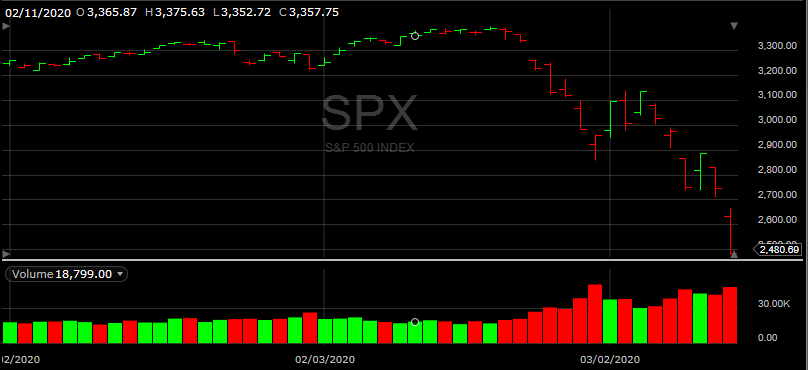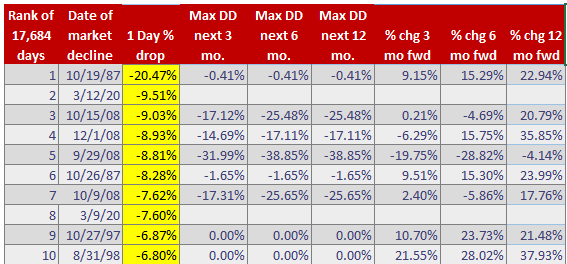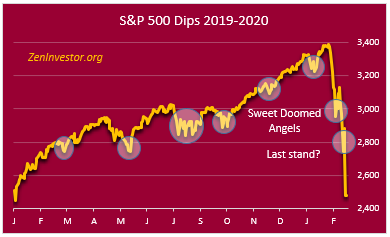Thursday was the 2nd worst day for the market since 1950
Investors' hearts have been broken once again today (unless you're still in denial). The Dow, NASDAQ, and S&P 500 are all now in a bear market. It's not easy, nor is it quick, to pull out of a bear market once you're in it. The average bear lasts 10 months, but many have lasted for years. Prepare yourself for a long slog through the mud.
Today's market action on a YTD scale
Today's market action was notable in two ways. First, it was the 2nd worst day since 1950. Second, there was a brief intraday rally of 100 points that fizzled and ended lower than where it began. This is a sign of capitulation on the part of the dip-buyers, but the worst is yet to come.
Another historic market decline today
Today's market drop ranks as the 2nd worst day out of 17,684 trading days since 1950. If we're not careful, we might exceed 2008 as the longest series of historic down days in history.
The table below shows the 10 worst market drops since 1950. Note that 4 of them were from 2008. The worst of the worst was an outlier - Black Monday, 1987. Could we be headed for another Black Monday? I don't know, but today's market drop and the recent series of drops are concerning.
Is there any good news? Yes, if you believe in oversold bounces, as I do. The question is how to play them? Do you assume that they will run up to make new highs? Or do you use them to unload weak holdings and get short?
It's up to you, of course, but we're in a very fluid market that could go either way. How confident are you in the way you're playing it?
Dip-buyers' last stand got crushed today
This chart reveals something important. It covers the period from January 2019 to today. You can see every dip, and the success of the dip-buyers all along the way. Up until recently, that is.
When the market topped on February 19th, the dip-buyers were still in control and they have been buying all the way down. There were 7 consecutive down days from the 19th to the 28th of February, and the dip-buyers were there for all of them. The problem is that the rally-sellers had more ammo and they overwhelmed the dip-buyers.
Then, on March 2nd, the rally-sellers took a break and the dip-buyers took the market up by 4.6%. I have named this the "Sweet Doomed Angels" rally.
After that, the rally-sellers returned and drove the market lower, to where it ended today. The S&P 500 is now down 25% from the high water mark it made on February 19th. This could have been the dip-buyers' last stand, but it didn't hold today.
Final thoughts
On Christmas Eve of 2018 the market was down by 19.8% and the dip-buyers rallied it all the way back to new highs. It could happen again. But we didn't have a pandemic back then, and we didn't have a crude oil price war either.
We didn't have countries quarantining a third of their population, or sports events taking place with empty stadiums. This isn't 2018. Things are bad, and they could get worse. Companies in hard-hit sectors are initiating massive layoffs. Corporate earnings estimates are coming down. Travel & Leisure - the largest component of US GDP - is among the hardest hit sectors of the economy.
On the positive side, rates are low, the Fed is ready to help, and more fiscal stimulus is coming. Will it be enough to keep the global economy from slipping into a new recession? Again, I don't know. But it doesn't look good.




Another excellent article. It sounds like it’s time to buckle in and invest in safe funds. What do you recommend?
Hey Erik,
Yesterday , my Fidelity app incredibly showed among Fidelity customers there was a preponderance of buyers to sellers with many “top” stocks (AAPL, BA, T, JNJ, etc.) Could you explain?
Pure bargain hunting, I expect.
Try VPU.
Thanks Erik. Hope to hear from you daily, if possible, till things settle down.